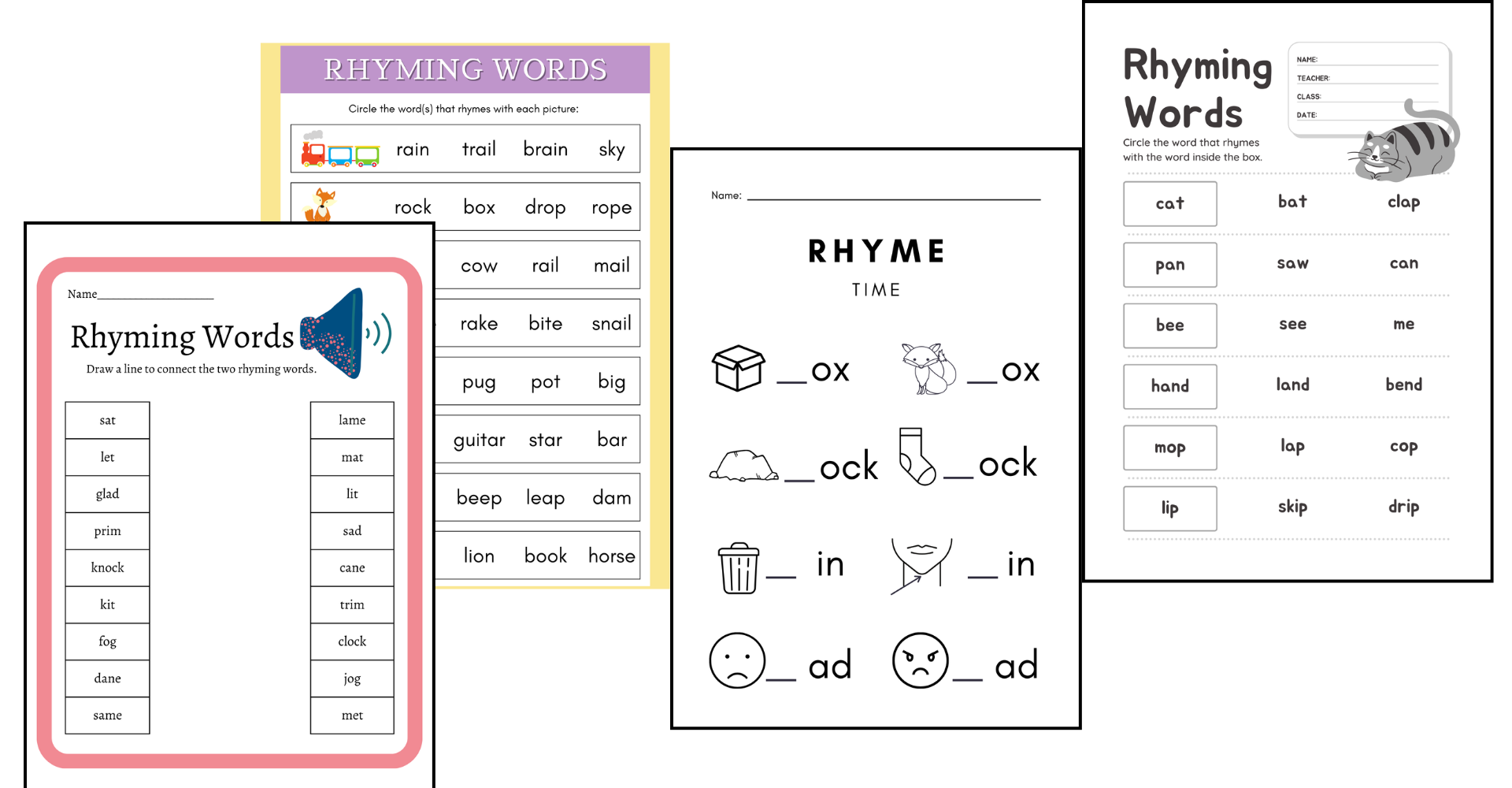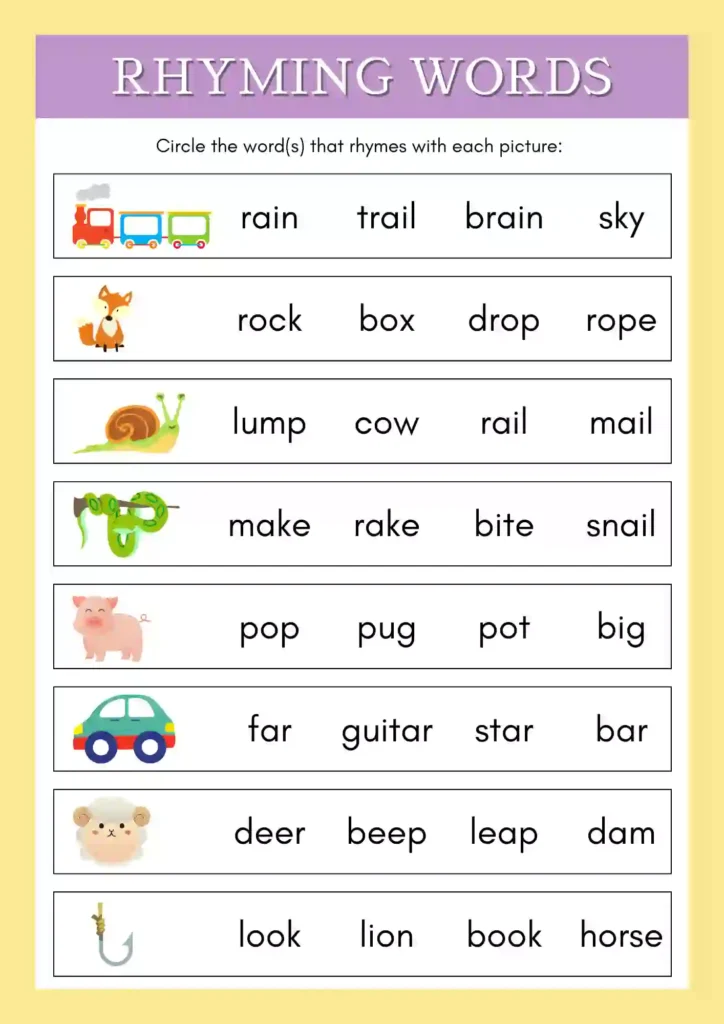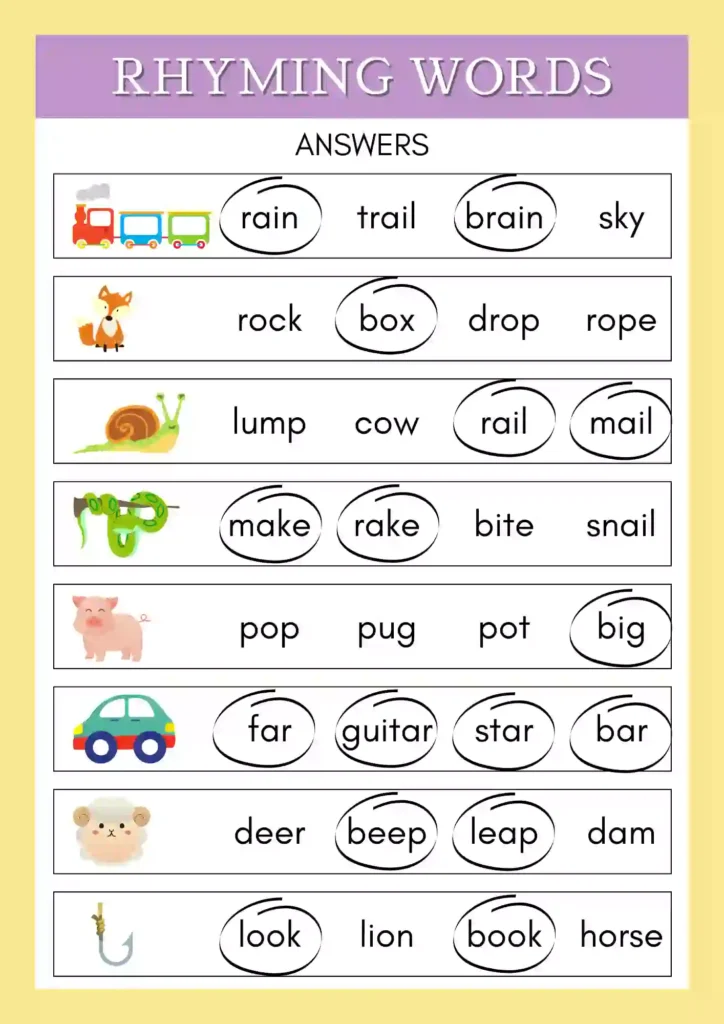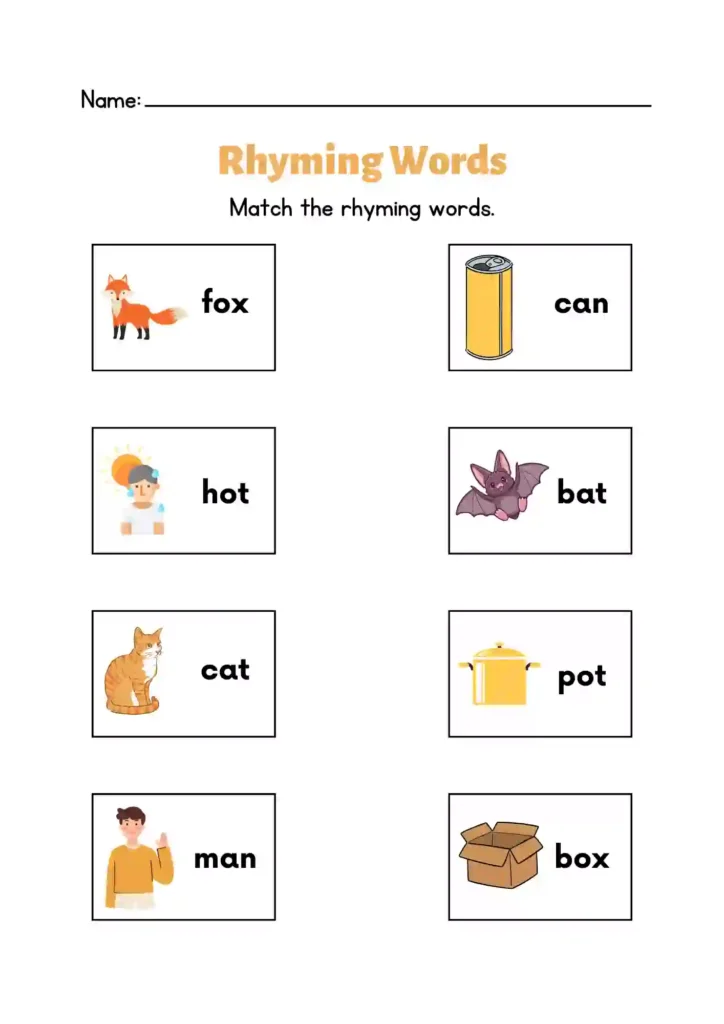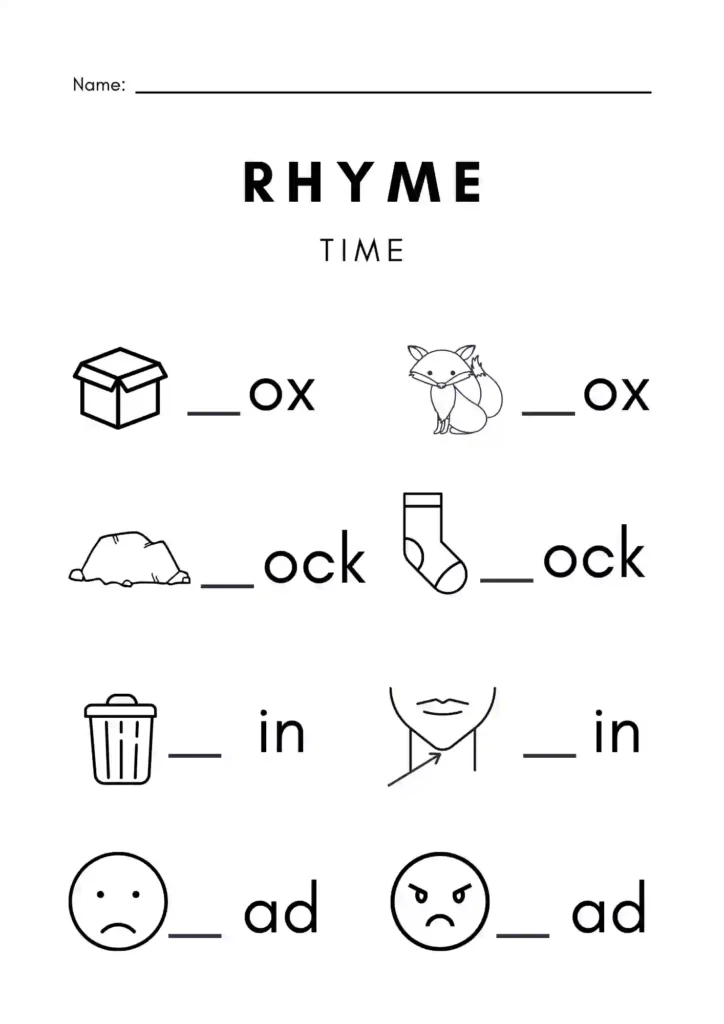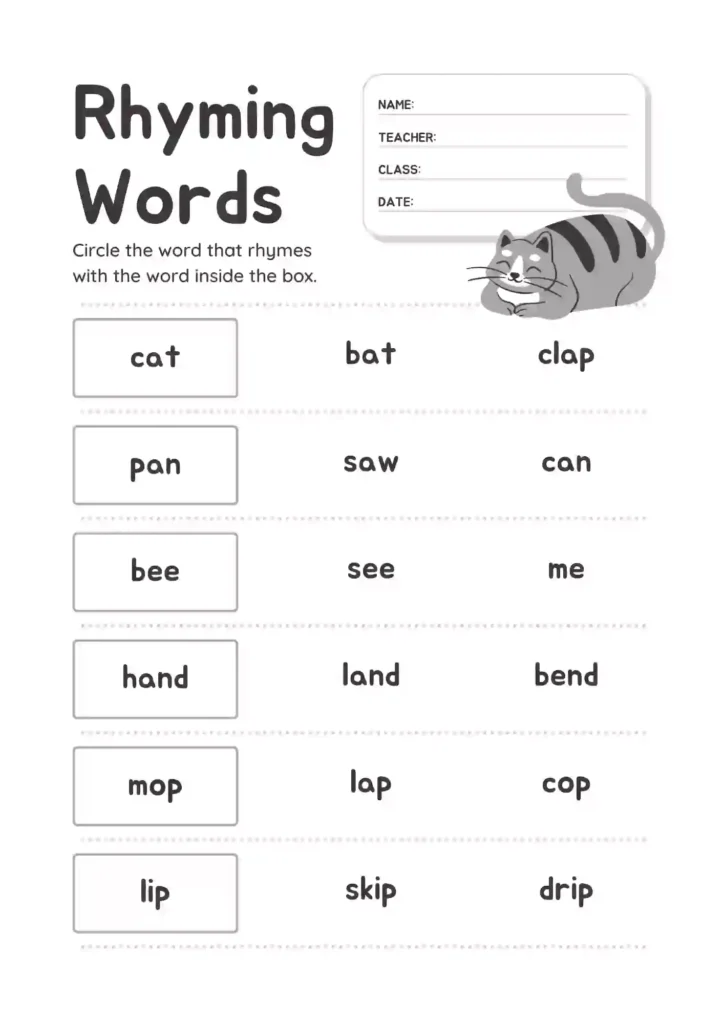Rhyming is an important skill for young children to learn as they start their journey into reading and writing. Our Kindergarten Rhyming Words Worksheets are designed to make this learning process fun and enjoyable for kids. With six interactive worksheets, your child will get to match pairs of rhyming words and circle words that sound similar. This playful approach helps them build a strong foundation for becoming great readers and writers in the future.
Kindergarten Rhyming Words Worksheets Details:
| Feature | Details |
|---|---|
| Format | Downloadable PDF |
| Number of Pages | 6 |
| Content | Kindergarten Rhyming Words Worksheets with activities like matching rhyming words and circling rhyming words |
| Illustrations | Yes, playful and age-appropriate |
| Suitable For | Nursery, Lkg & Ukg |
| Printable? | Yes |
Learning Objectives
- Recognizing Rhyming Words: Students will learn to find words that sound similar, like “cat” and “hat.” This fun activity helps them improve their listening skills and understand what rhyming means. They will enjoy the silly sounds and discover how some words can be paired together because they rhyme.
- Matching Rhyming Pairs: Children will practice connecting rhyming words by drawing lines between pairs that sound alike. This exercise helps them understand rhymes better and adds new words to their vocabulary. They will feel proud when they correctly match words that sound the same.
- Circling Rhyming Words: Students will look at a group of words and circle the ones that rhyme. This activity encourages them to listen closely to the sounds in words and see how some words sound the same. They will have fun searching for rhyming words and showing off their new skills.
- Improving Sound Awareness: By taking part in rhyming activities, children will get better at recognizing and working with the sounds in spoken words. This skill is very important for reading well. They will develop a strong foundation for learning to read and spell.
- Building Vocabulary: As children play with rhyming words, they will learn new words that sound similar. This helps them connect different words and understand what they mean more clearly. They will expand their vocabulary and have more words to use when speaking and writing.
- Developing Creativity: Rhyming activities encourage children to think creatively and come up with their own rhyming words. They will enjoy the challenge of finding words that sound alike and may even create silly rhymes of their own. This helps them express their creativity and have fun with language.
Who is this for?
These worksheets are suitable for kids in LKG, UKG, Nursery, preschool, and kindergarten, These worksheets provide an excellent foundation for early literacy skills, making them ideal for classroom use, homeschooling, and supplementary learning at home.
Materials Needed
- Printed copies of the Kindergarten Rhyming Words Worksheets
- Crayons or colored pencils
How to Use
- Introduce the Activity: Start by telling the children about rhyming words. Explain that rhyming words are words that sound the same at the end. For example, you can say that “cat” and “hat” are rhyming words because they both end with the same sound. Give them more examples, like “dog” and “frog,” to help them understand better.
- Demonstrate: Pick one of the rhyming worksheets and go through it together as a class. Show the children how to find rhyming pairs by matching them or circling the words that sound alike. Make sure to point out the similar sounds in each pair so they can hear the connection.
- Suggested Practice: Let the children work in small groups or pairs to finish the other worksheets. Encourage them to discuss their answers and help each other. Be available to give guidance and support if they have questions or need help.
- Independent Practice: After the children feel comfortable with rhyming, give them time to work on the worksheets by themselves. This will help them practice what they’ve learned and build their confidence in recognizing rhyming words.
- Review and Discuss: Once everyone has finished the worksheets, bring the class together to go over the answers. Talk about the rhyming pairs and the words they found, emphasizing the similar sounds. This will help reinforce their understanding of rhymes.
Tips
- Using Visual Aids
Try using picture cards or real objects to help kids understand rhyming words. For example, you can show them a picture of a cat and a hat. This makes it easier for them to see how the words sound alike. - Include Fun Songs and Stories
Bring rhyming songs, poems, and stories into your lessons. Kids love music and stories, and these can make learning about rhymes much more fun and memorable. Sing together or read a silly poem that has lots of rhymes! - Encourage Creativity
Ask the children to think of their own rhyming words. You can also invite them to make up funny sentences using pairs of rhyming words. For example, they might say, “The cat in the hat sat on a mat!” This helps them get creative while practicing their rhymes. - Incorporate Movement
Combine learning with physical activity. Create a game where children jump or clap every time they hear a rhyming word. This helps them engage both their minds and bodies, making the learning experience more dynamic and enjoyable.
Additional Activities
- Play Rhyming Games: Play fun rhyming games together, like “I Spy” or “Rhyming Bingo.” For example, in “I Spy,” one person says “I spy something that rhymes with cat” and the other person has to guess a word that rhymes, like “hat” or “mat.” These interactive games make learning about rhyming words fun and exciting for little ones.
- Make a Rhyming Word Wall: Create a special rhyming word wall in your home or classroom. So that children learn new rhyming words. They can write them down or draw pictures of them and add them to the wall. Seeing all the rhyming words together helps reinforce the concept that some words sound alike at the end. Your child will enjoy watching the rhyming word wall grow!
- Write Rhyming Stories: Encourage your child to write their own silly rhyming stories or short poems. They can make up a story with words that rhyme or write a simple rhyming poem. Have them illustrate their rhyming writing with fun pictures. Putting rhyming words into their own creative writing helps kids understand rhyming in a hands-on way. Plus, it’s a great way to boost their reading, writing, and imagination skills!
Download the PDF File Here:
Click To Download the Kindergarten Rhyming Words Worksheets PDF
How to Print:
- Get the PDF: Start by clicking the link to download the PDF files of the worksheets.
- Set up Printing: Make sure your printer is all setup. You can adjust the settings like paper size, whether it’s portrait or landscape, and how clear you want the print to be.
- Check Before You Print: Take a print preview. To make sure everything looks just right before you hit print.
- Print: Once you’re happy with how it looks, go ahead and hit that print button.
Tips for Parents and Educators
- Encourage and Support: Always try to give kids lots of praise and encouragement. When you notice them doing something good, let them know! This can help build their confidence and make them feel more motivated to try new things.
- Create a Safe Learning Space: Make sure that the learning environment is welcoming and fun. Children should feel safe and comfortable to share their thoughts and experiences. When they feel supported, they are more likely to participate and express their ideas.
- Work Together with Others: Don’t hesitate to team up with other parents and teachers. Sharing ideas, resources, and teaching methods can be very helpful, especially when it comes to teaching skills like rhyming. Working together can make learning more enjoyable for everyone involved!
Common Mistakes and Solutions
- Confusing Similar-Sounding Words: If kids get mixed up with words that sound alike but don’t rhyme, give them clear examples of words that rhyme and practice finding similar sounds together. For instance, you could say “cat” and “hat” rhyme because they end with the same “at” sound, but “cat” and “dog” don’t rhyme even though they both start with “c”. Have the kids listen to the ending sounds and see if the words match up.
- Lack of Engagement: If kids seem bored or not interested in learning, try adding more fun, interactive activities like games or songs to make it more enjoyable. For example, you could play a rhyming game where you say a word and they have to come up with a rhyming word, or sing a silly song about rhyming words. When kids are having fun, they’re more likely to stay engaged and learn better.
- Difficulty Identifying Rhyming Words: If kids struggle to figure out which words rhyme, give them extra practice and support. Use pictures or objects to help them see the connection between words that sound the same. For instance, show them a picture of a cat and a hat and have them say the words out loud. Then show them a picture of a cat and a dog and have them notice that those words don’t rhyme, even though they both start with “c”. With some extra help and repetition, kids will get the hang of identifying rhyming words in no time!
How to Create Your Own Rhyming Words Worksheets
Step 1: Choose the Rhyming Words
Start by selecting a set of rhyming words you want to focus on. Aim for pairs that are simple and commonly used, such as “cat” and “hat,” “dog” and “frog,” or “sun” and “fun.” This will help children easily recognize and remember the rhymes.
Step 2: Design the Worksheet Layout
Create a clear and visually appealing layout for your worksheet. You can use a grid format or a list. Here are a few ideas for activities to include:
- Matching Activity: List rhyming words in two columns and ask children to draw lines connecting the pairs.
- Circle the Rhymes: Provide a selection of words and ask children to circle the ones that rhyme.
- Fill in the Blanks: Write sentences with missing rhyming words and have children fill in the blanks with the correct words.
Step 3: Include Visuals
Add colorful illustrations or images related to the rhyming words. For example, if you are using “bat” and “hat,” include pictures of a bat and a hat. Visuals help children make connections between words and reinforce their understanding.
Step 4: Write Clear Instructions
At the top of the worksheet, include simple instructions that explain the activity. For example, “Draw a line to match the rhyming words” or “Circle all the words that rhyme with ‘cat.'”
Step 5: Make It Fun and Engaging
Use bright colors and fun designs to make the worksheet visually appealing. Consider adding some playful elements like borders or themed graphics to capture children’s interest.
Step 6: Test Your Worksheet
Before finalizing your worksheet, try it out with a few children to see how they engage with it. Observe their responses and adjust any confusing elements to ensure clarity and effectiveness.
Step 7: Print and Use
Once you’re satisfied with your worksheet, print it out and use it with your child or students. Encourage them to share their thoughts and experiences as they complete the activities.By following these steps, you can create customized rhyming words worksheets that not only support literacy development but also make learning enjoyable and interactive for young learners.
Leave a Comment
We value your feedback and experiences! Share your thoughts and suggestions in the comments section below.
Love from LkgWorksheets!
